Welcome to Part 4 of the Deep Learning Interview Questions Series, where we explore critical topics related to training dynamics, scalability and real-world deployment. As AI models become more powerful and widespread, understanding how to optimize, scale, and maintain them is essential for modern deep learning engineers.

This part will equip you with strong theoretical knowledge and practical tools expected in senior-level ML roles, applied research teams, and production engineering environments.
31. What are common optimization techniques in deep learning?
Optimization is central to training neural networks effectively. Core techniques include:
- Gradient Descent Variants: SGD, Adam, RMSprop, Adagrad
- Learning Rate Schedules: Step decay, cosine annealing, warm restarts
- Weight Initialization: Xavier/Glorot, He initialization
- Gradient Clipping: Prevents exploding gradients
- Batch Normalization: Accelerates convergence
These methods help avoid vanishing/exploding gradients, stabilize training, and improve convergence speed.
32. What are Scaling Laws in Deep Learning?
Scaling laws describe how model performance improves with increases in data, model size, and compute.
Empirical findings (OpenAI, DeepMind):
- Test loss and accuracy scale predictably with log(parameters), log(data)
- Larger models trained on more data and compute tend to perform better
- Diminishing returns kick in eventually
These laws are useful for planning infrastructure, pretraining budgets, and system design for foundation models.
33. What is Efficient Inference in Deep Learning?
Efficient inference refers to deploying deep models with low latency and resource usage.
Techniques include:
- Quantization: Use int8 or float16 instead of float32
- Pruning: Remove redundant weights
- Knowledge Distillation: Use a smaller student model trained on a large teacher model
- ONNX / TensorRT / TorchScript: Frameworks for optimized deployment
- Batching and model caching: Reduces compute during serving
These are essential for deploying AI in real-time systems, mobile apps, and edge devices.
34. What is Federated Learning?
Federated Learning allows training machine learning models across decentralized devices holding local data, without sharing that data centrally.
Key properties:
- Privacy-preserving (data remains on-device)
- Communication-efficient aggregation (e.g., FedAvg)
- Challenges include model drift, client heterogeneity, and security attacks
Use cases:
- Predictive keyboards
- Personalized health tracking
- Collaborative recommendation systems
35. What is Lifelong Learning in Deep Learning?
Also called continual learning, it is the ability of a model to learn continuously from a stream of tasks without forgetting previous ones.
Key challenges:
- Catastrophic forgetting
- Transfer learning across tasks
- Capacity saturation
Methods:
- Elastic Weight Consolidation (EWC)
- Progressive Neural Networks
- Replay buffers / rehearsal techniques
Lifelong learning is vital for agents in dynamic environments and robotics.
36. What is Mixed Precision Training?
Mixed precision uses both 16-bit and 32-bit floating point numbers during training, reducing memory usage and speeding up training on modern GPUs.
Benefits:
- Higher throughput
- More models fit into GPU memory
- Lower training cost
Tools: NVIDIA Apex, PyTorch AMP, TensorFlow mixed precision API
37. What is Hyperparameter Optimization?
Hyperparameters (learning rate, batch size, etc.) greatly impact training quality. Common tuning methods:
- Grid Search: Try all combinations
- Random Search: Random combinations (more efficient)
- Bayesian Optimization: Uses a probabilistic model to select next best point
- Hyperband / ASHA: Resource-efficient multi-arm bandits
Frameworks: Optuna, Ray Tune, Weights & Biases Sweep, Google Vizier
38. What is Early Stopping and Why Is It Important?
Early stopping halts training when validation loss stops improving. This avoids overfitting and saves compute.
Implementation:
- Monitor val_loss
- Set patience (e.g., 5 epochs)
- Roll back to best checkpoint
Often combined with learning rate scheduling.
39. What is Model Compression?
Model compression reduces the size of neural networks while preserving accuracy.
Approaches:
- Weight Pruning
- Quantization
- Low-Rank Factorization
- Distillation
Compression enables faster inference, mobile deployment, and lower energy usage.
40. What are Real-World Deployment Challenges?
Deploying deep learning systems requires addressing:
- Latency constraints (real-time requirements)
- Hardware limitations (memory/compute limits)
- Data drift (changing distributions)
- Monitoring and versioning (MLOps practices)
- Ethical compliance (privacy, fairness)
Toolchains: MLflow, TFX, BentoML, Seldon, HuggingFace Inference Endpoints
Conclusion
In Part 4 of our Deep Learning Interview Questions Series, we focused on optimization and deployment topics that are crucial in production-level AI. Mastery of these concepts prepares you not just for interviews, but also for building robust, scalable, and ethical deep learning systems.
Coming soon in Part 5:
- Multimodal foundation models
- Open-source vs proprietary LLMs
- RLHF (Reinforcement Learning with Human Feedback)
- Alignment and safety
- Evaluation frameworks for LLMs
Stay tuned for the next post…
Related Read
Deep Learning Interview Questions – Part 3

1 thought on “Deep Learning Interview Questions – Part 4”